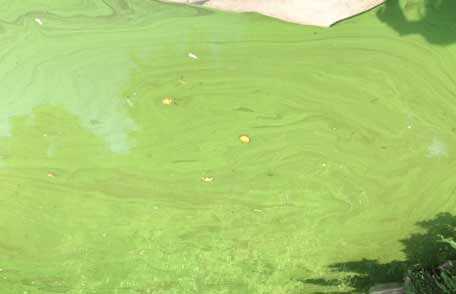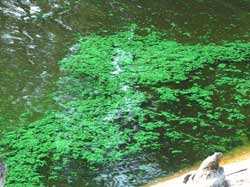Harmful Algal Blooms

Photo credit: New York State Department of Health
Harmful algal blooms can produce toxins that are dangerous to people, animals, and the environment. Learn what harmful algal blooms are, how you and your pets can avoid them, and what CDC is doing to protect the public’s health.
Warm weather brings many happy occasions: picnics, ballgames, and back yard fun. It also is a time when microscopic plant-like organisms – algae and cyanobacteria – are more likely to overgrow in rivers, lakes, and oceans.
These overgrowths, called algal blooms, occur across the country. Sometimes they are just eyesores – an unpleasant scum or mats of green, red, blue, or brown organisms in the water that look or smell bad. Sometimes they also cause harm to people, animals, and the environment. In this case, they are known as harmful algal blooms. But you can’t tell if a bloom is harmful just by looking at it.
Be Aware of Harmful Algal Blooms
Harmful algal blooms can produce toxins that can make people and animals sick. They also can block sunlight or use up a lot of oxygen in a body of water, which kills fish and plants in the water. Harmful algal bloom toxins have caused the shutdown of the water supply in a major U.S. city, killed wildlife and pets, and sickened hundreds of people with a variety of skin, breathing, neurological, and stomach symptoms.
People and animals can be exposed to algal toxins in many ways:
- Swimming or coming in direct contact with the toxins.
- Breathing in the toxins.
- Swallowing contaminated water that contains toxins.
- Eating seafood contaminated with toxins.
Animals can often be the first affected because they are more likely to swim or drink from bodies of water that contain algal blooms.
Harmful algal blooms have occurred in every region of the United States. In 2014, 38 states responded to a survey about harmful algal blooms, and more than half reported that such blooms occur every year in a freshwater body. All coastal states have reported harmful algal blooms in marine waters, and these blooms also have been reported in all the Great Lakes. Evidence suggests that harmful algal blooms are increasing in number and severity because of changing temperatures, farming practices, storm water runoff, and wastewater overflows.

Collecting Data to Protect Health
Because harmful algal blooms affect people, animals, and the environment, it’s important to document when they happen, where they happen, and whether they cause illness. CDC’s One Health Harmful Algal Bloom System (OHHABS), is a web-based national reporting system for harmful algal blooms. State and territorial public health departments and their designated environmental health or animal health partners can use this voluntary system to report harmful algal bloom events and associated illnesses in people and animals. The data collected helps CDC and partners learn more about these blooms and understand how to best prevent the illnesses they cause.
Harmful algal blooms are an example of a One Health issue. The One Health approach recognizes that human, animal, and environmental health are connected. Using this approach to track harmful blooms highlights the opportunity for human health, animal health, and environmental health experts to work together to effectively address the problems that harmful algal blooms can cause.

Harmful algal bloom in Chain Lake. Photo credit: Washington State Department of Health.
Tips for You and Your Pets to Stay Healthy
You can’t tell if an algal bloom is harmful just by looking at it. Also, not all blooms are easy to see—toxins can be present even when you can’t see the bloom. To protect yourself and your pets, avoid entering or playing in bodies of water that:
- Smell bad.
- Look discolored.
- Have foam, scum, or algal mats on the surface.
- Contain or are near dead fish or other dead animals (for example, don’t go in a body of water if dead fish have washed up on the shore or beach).
Check for beach advisories in your state that may be posted online or on signs near the water. Follow local or state guidance if you learn about a harmful algal bloom in a local water body or if you are notified that your tap water contains algal toxins. Know the health risks of eating contaminated fish and shellfish and follow advisories.
If you think you or your pet have become ill from exposure to a harmful algal bloom, see your healthcare provider or veterinarian. Animals can get very sick, so don’t delay contacting your veterinarian if you think your pet has been exposed. If you have immediate questions about symptoms that you are experiencing, your local or state poison information center might be able to provide information.
More Information
- CDC – Harmful Algal Bloom-Associated Illnesses Website
- Environmental Protection Agency (EPA) – CyanoHABs Website
- U.S. Geological Survey – The Science of Harmful Algal Blooms
- National Oceanic and Atmospheric Administration (NOAA) – Harmful Algal Bloom Website
- NOAA Harmful Algal Bloom and Hypoxia Research Control Act
- Page last reviewed: July 12, 2017
- Page last updated: July 12, 2017
- Content source:
- National Center for Emerging and Zoonotic Infectious Diseases, Division of Foodborne, Waterborne, and Environmental Diseases
- Page maintained by: Office of the Associate Director for Communication, Digital Media Branch, Division of Public Affairs




 ShareCompartir
ShareCompartir